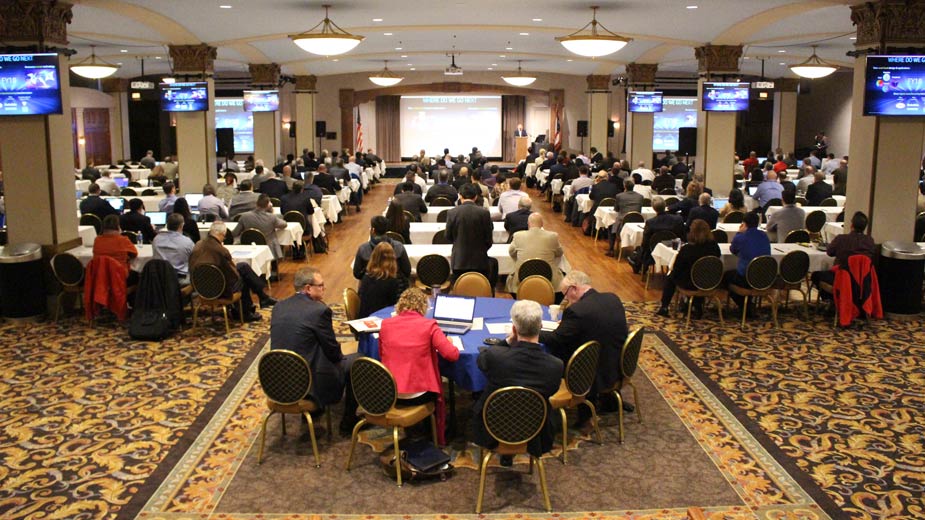America Makes Annual Meeting: Public/Private Partnerships a Must
YOUNGSTOWN, Ohio – A panel composed of engineers and manufacturing specialists in the public sector agree that government collaboration with the private sector through innovation hubs such as America Makes is integral to strengthening this country’s industrial base and its ability to defend itself.
“We need those close partnerships, and want to maintain those close partnerships,” said Dennis Butcher of the U.S. Air Force Research Lab.
Butcher was on a panel of five who spoke Wednesday during the afternoon session at America Makes’ annual Members Meeting and Exchange at Stambaugh Auditorium . Joining Butcher were Valri Lightner of the U.S. Department of Energy’s Advanced Manufacturing Office, Ben Bouffard an additive manufacturing specialist for the Navy, Steven Schmid of the National Science Foundation, and Stacey Clark of the Army.
The panel pointed out that additive manufacturing stands to improve U.S. combat readiness, technological innovation, and opportunities for workforce development within the armed forces.
This, they say, is best accomplished when the private and public sectors work together, and institutions such as America Makes and the 13 other innovation hubs established in the Manufacturing USA network help facilitate these partnerships and new research.
The premise was to have the federal government commit five years to seed these innovation hubs with the understanding that they would transition to the private sector, Butcher said. However, he said, the department is seeing great benefits from these public/private partnerships and the program’s model is being re-evaluated. “The thinking is starting to shift,” he said. “We recognize that we need a close partnership to maintain the value that we’re getting out of the institute. It’s very difficult to pull off without organizations such as America Makes.”
These partnerships have also led to improvements in workforce development programs supported by the Office of the Secretary of Defense, or OSD, Butcher said. “The department was seeing what was going on here, and it was above and beyond our original agreements,” he said.
America Makes is the first of 14 innovation hubs the Obama Administration created in 2012. The institute was created to foster research and development in additive manufacturing, better known as 3-D printing. The technology allows systems to build complex shapes and components from the ground up with a variety of materials – metals or polymers, for example — using digital models and files as their guide.
This technology is especially important for the Navy, Bouffard said. “We have some systems that were designed for 25 years,” he told his audience. “Some of them are going on their 45th year now.”
That means it’s nearly impossible to find parts or components that could accommodate these antiquated systems, Butcher noted. However, through the use of additive manufacturing, an engineer could digitally reconfigure a broken component, send the file to a 3-D printer, and that printer could essentially “print” the part on site.
“These parts just aren’t available anymore,” he said. “Additive manufacturing can assist this.”
Through 3-D printing, the Navy could build what it calls “micro-factories” installed at waterfront sites capable of printing a critical part or component in a handful of hours, he said.
Additive manufacturing also addresses priorities and concerns in the Army, Stacey Clark said. These include military readiness, new weapons systems and support for troops and their families.
Some troops in the field, for example, are trained on rudimentary 3-D printers that are portable, yet effective in forward areas, she noted. These soldiers can inquire about a part for an armored vehicle stored in a secure database, call that component up and send the file to the small printer. If the base can’t locate the part, then one of the troops could reverse engineer the component and manufacture it on the printer, she explained.
Other representatives in federal departments say that 3-D printing has emerged as an important part of core research in their advanced manufacturing divisions.
Most funding for additive manufacturing at the Department of Energy goes to the Oak Ridge National Laboratory in Tennessee, added Lightner, deputy director of Energy’s advanced manufacturing office. “Our funding at its high is about $60 million per year,” she said. “Probably about 75% of that goes to core research and development.”
Oak Ridge experiments with new equipment to assess how to make products larger and faster by using additive and other advanced manufacturing methods, Lightner said. The lab has research and development agreements with corporate partners that require 50/50 cost sharing on different projects, she said. “It is a competitive process, because we want to be focused on different challenges from multiple companies.”
Schmid, program director for the manufacturing machines and equipment division of the National Science Foundation and professor at the University of Notre Dame, said the organization has a long history of additive manufacturing.
“It started in the early 1980s,” when the technology was relatively new. The foundation, Schmid noted, looks to fund and support new ideas that can translate to scientific breakthroughs with a global impact. “My program has the process projects, and about 40% of our grants are in additive manufacturing these days,” he said, which encompasses materials engineering and research. New pioneering efforts could result in opportunities in additive manufacturing in biomedical applications that include organ printing, albeit that is some 20 years away.
“These are based on additive manufacturing technologies that require significant innovations in machinery, as well as biology to bring these to fruition,” Schmid said. “It’s exactly the kind of thing that NSF can invest in where other agencies don’t have the ability.”
Schmid urged companies or individuals to “think big” before they seek funding from the NSF. “Bring the big ideas,” he advised. “When you got to the National Science Foundation, be bold. Be new.”
Copyright 2024 The Business Journal, Youngstown, Ohio.



